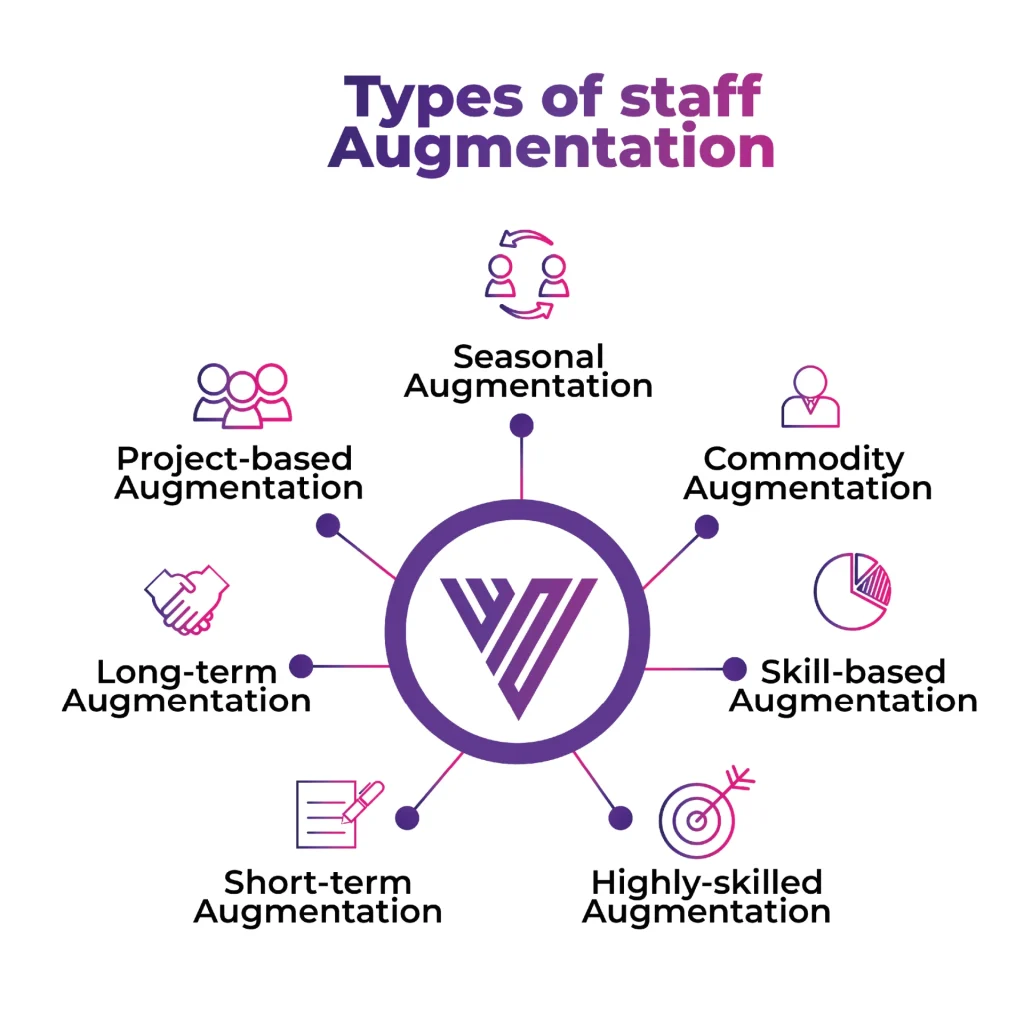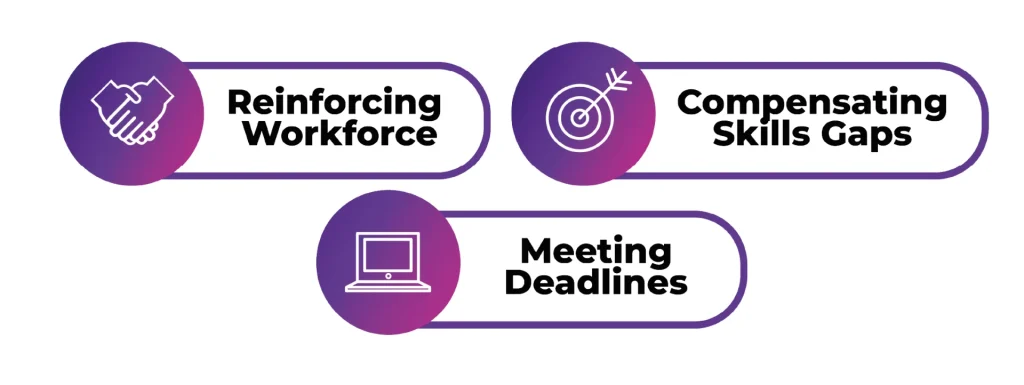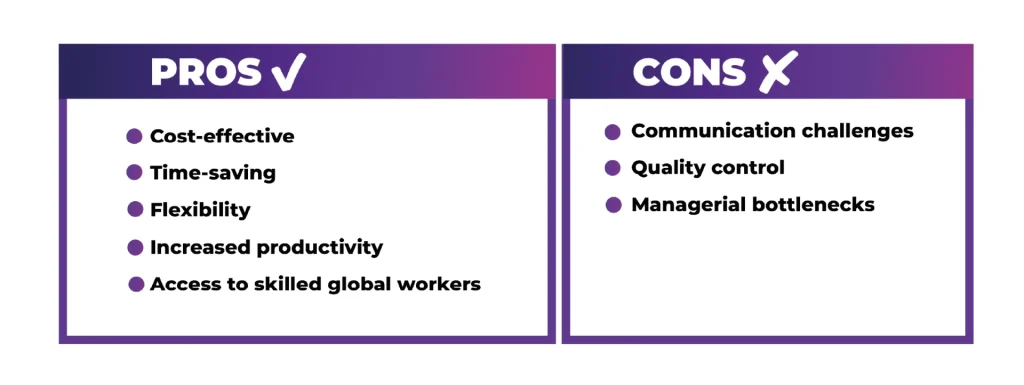With the rapid technological change, companies need to stay at the top of their game, being able to adapt and stay competitive. To stay attuned to the needs of their clients, companies may resort to staff augmentation to meet their goals. By outsourcing skilled professionals, businesses will remain innovative and capable of developing new ideas and projects, meeting deadlines while delivering the best results.
Table of Contents
What is and how does Staff Augmentation work
At this point, you may be wondering what staff augmentation is and what it entails. In this article, you’ll find the answers you are looking for.
Staff augmentation helps companies fill in workforce gaps temporarily by hiring people from outside the company. These resources help supplement the existing in-house workforce and enhance productivity. By leveraging staff augmentation services, companies can quickly hire skilled and specialized workers for certain jobs without the lengthy process of regular hiring.
For this reason is an effective approach for companies to satisfy certain workforce needs. In this way, companies can also scale their workforce needs based on project requirements, or business growth.
In turn, staff augmentation is not only cost-effective, but it allows talent and specialized resources to be reachable across industries. Companies specializing in staff augmentation have access to a network of skilled workers, including developers, designers, and project managers, among others, to integrate into their client’s existing team.
Types of Staff Augmentation
When companies are looking to outsource, there are different types of staff augmentation services that they can consider based on their specific needs and requirements. It is important to understand what staff augmentation can offer so you can choose the strategy that better suits the specific business needs.

Some possible scenarios to consider relying on staff augmentation may include:
- Increasing the workforce to fulfill a specific project and increase productivity,
- When looking to build a long-term working team,
- When there is a need for specialized workers with skills that nobody on the current team has,
- When looking to make cost-effective decisions and have access to professionals who can bring new ideas to the table.
| Type of Staff Augmentation | Description | Ideal for Companies That |
|---|---|---|
| Commodity Augmentation | Hiring for roles that require standardized skills widely available in the market. | Need to quickly scale up for routine tasks without specialized skills. |
| Skill-based Augmentation | Focusing on specialized skills and knowledge that may not be available in-house. | Require specific expertise for short-term projects or to fill immediate skill gaps. |
| Highly-skilled Augmentation | Involves outsourcing top-tier professionals with advanced expertise in their field. | Are working on complex, innovative projects and need industry-leading experts. |
| Short-term Augmentation | Hiring staff for brief periods, typically to handle temporary increases in workload. | Experience short-term spikes in demand or need to cover for employee absences. |
| Long-term Augmentation | Engaging staff for extended durations to work on long-term projects. | Have long-term projects and need ongoing support beyond their current team’s capacity. |
| Project-based Augmentation | Bringing on staff specifically for the duration of a project. | Embark on projects with clear timelines and need additional hands only for that period. |
| Seasonal Augmentation | Hiring additional workers during peak seasons or for cyclical work. | Experience seasonal spikes in demand and need to ramp up their workforce accordingly. |
Commodity augmentation
To maximize their workforce efficiency, a company can rely on commodity augmentation. This type of staff augmentation is useful when a company needs to carry out a task that requires basic or standardized skills that are readily available in the market. These roles typically do not require specialized knowledge, making them suitable for outsourcing or temporary staffing solutions.
By using commodity augmentation, a company can scale its workforce up or down based on a specific project demand. This does not require going through the long-term commitment of hiring full-time employees. This kind of flexibility is advantageous for businesses with fluctuating workloads or seasonal demands, as it allows them to maintain operational efficiency while reducing costs.
Skill-based augmentation
This type of staff augmentation focuses on providing a specialized connection between a company and skilled workers to fill gaps in knowledge that may not be readily available in-house. Considering this, we can say that skill-based augmentation can quickly help businesses adapt to changing project requirements and market demands without the need for long-term commitments.
By partnering with a management and development company that offers skill-based augmentation services, a business may gain access to specialized professionals with knowledge in different areas, including software development, data analysis, and digital marketing, among others. This type of staff augmentation service is convenient on a project-by-project basis, ensuring that your team has the capabilities needed to deliver high-quality results.
Highly-skilled augmentation
When in need of top-tier professionals in areas such as technology, management, software development, and others, a company may resort to highly skilled staff augmentation services. This type of staff augmentation allows a company to outsource skilled workers who provide specific expertise for a project or initiative to complement their existing in-house workforce.
Efficient and objective-oriented, highly-skilled staff augmentation makes it possible to access talent on-demand, saving time and resources on recruitment and training, while satisfying their staff needs. By leveraging this type of staff augmentation, businesses can get the best of innovation and reach the necessary competitiveness to stay on top of today’s fast-paced market.
When is the optimal time to rely on staff augmentation

When determining the optimal time to rely on staff augmentation, it is crucial to consider various factors. It is important to keep in mind that bringing in additional resources through staff augmentation can help maintain efficiency and meet customer demands while leveraging the expertise of external professionals.
| Scenario | Description | |
| Reinforcing Workforce | Augmenting staff during peak seasons or sudden workload spikes to stay competitive. | |
| Compensating Skill Gaps | Temporarily hiring experts to fill in-house deficiencies without a long-term commitment. | |
| Meeting Deadlines | Quickly scaling workforce to ensure timely project completion. | |
Reinforce the in-house workforce
To grow a business efficiently and stay competitive in today’s market, a company may look into reinforcing its in-house workforce by staff augmentation. This efficient and strategic resource can help a business stay atop of their project goals, by increasing productivity, and providing the skilled support the in-house team may need. This is particularly convenient during peak seasons, or when there is a sudden spike in workload.
Compensate skill gaps
Businesses looking to address deficiencies and skill gaps in their in-house workforce, or those who are looking to embark on new projects that require specific expertise, may benefit from staff augmentation. By utilizing staff augmentation services, companies can strategically fill these skill gaps with experienced professionals temporarily, without having to go through the process of hiring full-time employees.
Meet the deadline
Timely completion of projects can significantly impact the overall success of a business. By outsourcing through staff augmentation services, companies will be able to meet their deadlines by quickly scaling their workforce to meet project demands.
Pros and Cons of Staff Augmentation
When considering resorting to what is staff augmentation, it is necessary to keep in mind the pros and cons of this type of service, and whether it is a good fit for a specific business needs. Some of the pros and cons of staff augmentation may include the following:

Pros
Cost-effective. Outsourcing talent by staff augmentation represents an efficient option that allows companies to get access to skilled professionals without the hurdles and additional costs of recruitment, and other perks related to employees are covered by the services’ fee.
Time saving. Another benefit of staff augmentation services is that by skipping the traditional employee recruitment stage, you will be able to save precious time, often dedicated to creating job postings, interviewing candidates, paperwork, training, etcetera.
Flexibility. Staff augmentation makes it possible for companies to grow their team and resources based on their specific needs, giving them room to build the team that better suits their projects and goals. The opportunity to scale their workforce up and down based on projects or spans of time (monthly, weekly) makes it possible for companies to make decisions more freely and without restraints.
Increased productivity. Staff augmentation gives way to increased productivity, as the team that will complement the in-house workers of the company will be completely focused on the specific project they are assigned to. The tasks related to that project will also be a top priority, along with meeting the project’s specific deadline.
Access to skilled global workers. By resorting to staff augmentation, a company will no longer be bound to local talent supplies, as these services are available in many places. By connecting remotely, companies will be able to rely on skilled global workers to take over projects in a diligent way, making amazing results possible.
Cons
Communication challenges. Considering staff augmentation relies on workers who will likely not be in office, and may work remotely, communication challenges may arise. For this reason, it will be necessary to create communication channels to make the full integration between the outsourced workers and the in-house talent possible.
Staff Augmentation in Video Games Development
The use of what is staff augmentation has gained popularity in different areas in the last few years, but it has come especially handy in the game-developing field. Staff augmentation offers a unique solution for game development companies looking to scale their workforce quickly and efficiently, relying on outsourced professionals to take their visions into reality.
Companies enlist the services of external professionals to supplement their in-house teams, this may include programmers, artists, designers, and QA testers, among other talents, to meet the specific requirements of a developing project. This model not only allows companies to optimize resources to focus on core business activities, but also allows them to stay at the top of their game, meet and fulfill project demands, and render high-quality games to their audiences.
Get immersed in the world of game development and staff augmentation services with the help of Wizards today. Get in contact with our team to bring your vision to life!

Frequently Asked Questions About Staff Augmentation
What is staff augmentation?
Staff augmentation is an efficient approach with which companies hire skilled external professionals on a temporary basis to supplement their existing workforce. These resources help to enhance productivity, innovate, and develop new projects. These services give businesses access to diverse and specialized workers without having to go through the hassle of the traditional hiring processes.
When should a company consider staff augmentation?
Businesses should consider staff augmentation when they need to reinforce their in-house workforce or meet project deadlines. It is particularly beneficial during peak seasons or when the workload suddenly increases. Staff augmentation is also useful for compensating skill gaps and for embarking on new projects requiring specific expertise.
What are the pros and cons of staff augmentation?
The pros of staff augmentation include cost-effectiveness, time-saving, flexibility, increased productivity, and access to skilled global workers. However, there are also cons to consider, such as potential communication challenges due to the outsourced workers not being in the office and working remotely.
What are the different types of staff augmentation?
There are three main types of staff augmentation: commodity augmentation, skill-based augmentation, and highly skilled augmentation. Commodity augmentation involves outsourcing tasks that require basic or standardized skills. Skill-based augmentation focuses on providing specialized workers to fill gaps in knowledge that may not be available in-house. Highly skilled augmentation involves outsourcing top-tier professionals in areas such as technology, management, and software development.
How is staff augmentation used in video game development?
Staff augmentation has become popular in the field of video game development. Game development companies use it to scale their workforce quickly and efficiently by enlisting the services of external professionals, such as programmers, artists, designers, and QA testers. This model allows companies to optimize resources, focus on core business activities, meet project demands, and deliver high-quality games.




